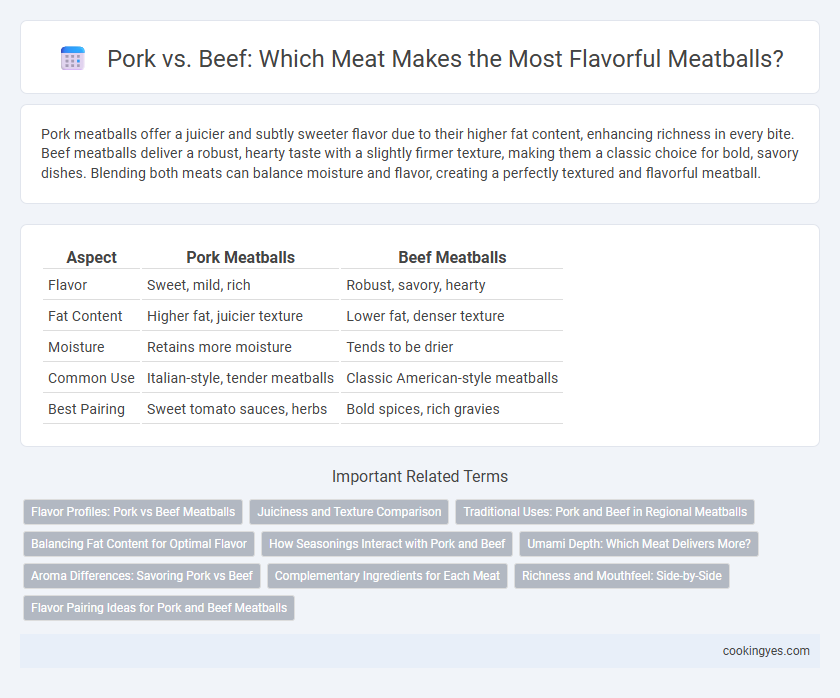Pork meatballs offer a juicier and subtly sweeter flavor due to their higher fat content, enhancing richness in every bite. Beef meatballs deliver a robust, hearty taste with a slightly firmer texture, making them a classic choice for bold, savory dishes. Blending both meats can balance moisture and flavor, creating a perfectly textured and flavorful meatball.
Table of Comparison
| Aspect | Pork Meatballs | Beef Meatballs |
|---|---|---|
| Flavor | Sweet, mild, rich | Robust, savory, hearty |
| Fat Content | Higher fat, juicier texture | Lower fat, denser texture |
| Moisture | Retains more moisture | Tends to be drier |
| Common Use | Italian-style, tender meatballs | Classic American-style meatballs |
| Best Pairing | Sweet tomato sauces, herbs | Bold spices, rich gravies |
Flavor Profiles: Pork vs Beef Meatballs
Pork meatballs offer a sweeter, fattier flavor with a tender, juicy texture, enhancing the richness and moistness of each bite. Beef meatballs deliver a robust, hearty taste with a firmer texture, providing a savory depth that balances well with strong spices and sauces. Combining both meats creates a perfect harmony of succulence and boldness, elevating the overall flavor complexity of meatballs.
Juiciness and Texture Comparison
Pork meatballs generally offer a higher fat content than beef, resulting in increased juiciness and a tender, succulent texture. Beef meatballs tend to have a firmer texture with a more robust, savory flavor due to their leaner profile, which can sometimes lead to a drier bite if not carefully cooked. Combining pork and beef in meatball recipes creates a balanced texture, enhancing moisture while maintaining structural integrity for optimal taste and mouthfeel.
Traditional Uses: Pork and Beef in Regional Meatballs
Pork is favored in traditional Italian and Swedish meatballs for its rich, juicy texture and slightly sweet flavor, enhancing the overall tenderness and moisture. Beef dominates in American and Middle Eastern meatball recipes, offering a hearty, robust taste that stands up well to bold spices and tomato-based sauces. Regional preferences highlight pork for a softer bite and beef for a denser, more intense meaty profile, shaping the signature flavors distinct to each cuisine.
Balancing Fat Content for Optimal Flavor
Balancing fat content is crucial when choosing between pork and beef for meatballs, as pork typically contains higher fat levels that add juiciness and richness. Beef offers a leaner profile but benefits from blending with fattier cuts or pork to prevent dryness and enhance flavor complexity. Optimal flavor comes from achieving a balanced fat ratio, ideally around 15-20%, combining pork's succulence with beef's robust taste for a moist and flavorful meatball.
How Seasonings Interact with Pork and Beef
Pork meatballs absorb seasonings like garlic, fennel, and sage, enhancing their natural sweetness and providing a tender, rich flavor profile. Beef's robust and slightly metallic taste pairs well with bold spices such as cumin, chili powder, and black pepper, which amplify its savory depth. Seasonings interact differently with pork and beef fats, influencing the meatballs' juiciness and overall flavor balance.
Umami Depth: Which Meat Delivers More?
Pork meatballs offer a richer umami depth due to higher levels of glutamates, enhancing savory complexity and juiciness. Beef meatballs provide a robust, bold flavor profile with iron-rich myoglobin that intensifies meatiness but can be less tender than pork. Combining pork and beef often balances the umami depth, creating a succulent, deeply flavorful meatball.
Aroma Differences: Savoring Pork vs Beef
Pork meatballs release a sweeter, milder aroma with subtle hints of fat that enhance the overall savoriness, creating a tender and juicy flavor profile. Beef meatballs offer a richer, more robust scent marked by deeper umami notes and a pronounced, hearty essence that intensifies the taste experience. The choice between pork and beef significantly impacts the meatball's aroma, with pork providing a delicate fragrance and beef delivering a bold, meaty bouquet.
Complementary Ingredients for Each Meat
Pork meatballs benefit from complementary ingredients like garlic, fennel, and sage, enhancing their naturally sweet and fatty flavor profile. Beef meatballs pair well with robust spices such as cumin, smoked paprika, and rosemary to balance their rich and hearty taste. Incorporating grated Parmesan and fresh herbs like parsley can elevate the overall flavor complexity in both pork and beef meatball recipes.
Richness and Mouthfeel: Side-by-Side
Pork meatballs deliver a richer, juicier mouthfeel due to higher fat content, which enhances tenderness and succulence. Beef meatballs provide a more robust, hearty flavor with a denser texture, creating a firmer bite. Combining both meats often balances richness and mouthfeel, yielding a flavorful, well-rounded meatball experience.
Flavor Pairing Ideas for Pork and Beef Meatballs
Pork meatballs offer a rich, slightly sweet flavor that pairs exceptionally well with herbs like sage, thyme, and spices such as fennel and garlic, enhancing their savory profile. Beef meatballs deliver a robust, hearty taste that complements bold ingredients like smoked paprika, cumin, and sharp cheeses like Parmesan or Pecorino Romano. Combining ground pork and beef in meatballs balances the flavors, creating a juicy texture that harmonizes with tomato-based sauces, fresh basil, and tangy marinara for a classic Italian pairing.
Pork vs Beef for meatball flavor Infographic

 cookingyes.com
cookingyes.com